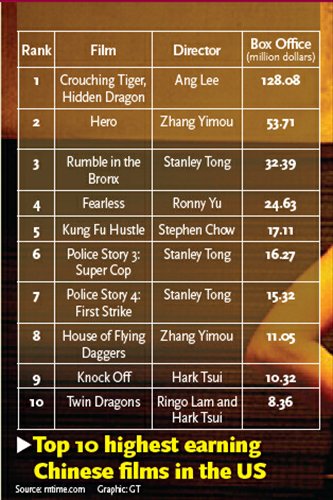

"What Chinese films have been loved by foreigners?" This is a question that has long bothered Chinese film industry insiders who want domestic works to be welcomed overseas. Yet, Chinese films still remain a niche concept outside their home country. Films produced 10 years ago, even 20 years ago, such as Farewell My Concubine (1993), To Live (1994), and Crouching Tiger, Hidden Dragon (2000), are still the most representative Chinese films in many foreign audiences' eyes.
This should come as no surprise, as American films hold a more than 92 percent market share of the global film market, while European films account for an additional 6 percent. This leaves Chinese films having to compete with countries like India and Japan for that remaining 2 percent.
Situation overseas
In the eyes of audiences outside China, "the Chinese film market" and "Chinese films" are completely different concepts - while the former represents box office and potential, the latter is much less attractive.
In 2013, the Chinese film market earned 21.80 billion yuan ($3.54 billion) in total box office revenue, bringing in an overwhelming 12.77 billion yuan domestic films accounted for over half this amount. However, all 45 of the Chinese films exported that year grossed only 1.41 billion yuan in the international market, less than the combined box office (1.45 billion yuan) Iron Man 3 and Pacific Rim earned in China that same year. Even box office miracles like Lost in Thailand (2012), which took in over 1.2 billion yuan at home, earned less than $100,000 in the North American market.
Ever since 2010, when overseas sales of Chinese films peaked at 3.5 billion yuan, that number has begun to reduce by 50 percent every year.
There is a phenomenon in China where commercial directors are not that eager to pursue the overseas market, while directors who made their names through foreign markets often depend more on European film festivals rather than domestic box office to earn a name for themselves.
In 1988, Zhang Yimou took the Golden Bear award at the 38th Berlin Film Festival, changing the stereotyped image Western audiences had towards Chinese people with his Red Sorghum (1987). Before that, were either men in long braids or the politically obsessed people in Michelangelo Antonioni's documentary Chung Kuo (1972).
During almost this same period, a series of films full of individual style and humanistic thinking like Farewell My Concubine, To Live, and Yellow Earth (1985), earned Chinese films a certain position outside the country: Some universities in the US even opened courses for Chinese film studies.
Meanwhile, in Hong Kong, directors like John Woo and Wong Kar Wai became another force altogether. Woo's The Killer (1989) became one of the favorite movies for rent in the US, and had an influence on Luc Besson's influential film Léon (1994).
During the decade from the early 1990s to the mid-2000s, Wong's atmospheric films, Chungking Express (1994), Happy Together (1997), In the Mood for Love (2000) and 2046 (2004) were examples of box office hits in the overseas market and his images of "women dressed in qipao" left strong impressions on foreign audiences.
Meanwhile, Taiwan director Ang Lee's family trilogy, Pushing Hands (1992), The Wedding Banquet (1993), and Eat Drink Man Woman (1994) provided a window for Western audiences to see ordinary Chinese people and families.
Over on the Chinese mainland, while films by sixth generation directors like Jia Zhangke may have been highly talked about among Western audiences, these directors' works were not well known at home: Sixty percent of the earnings for Zhang Yang's Shower (1999) came from the overseas market, while about half of the 10 million yuan investment into Lu Chuan's Ke Ke Xi Li (2004) was paid back from foreign audiences. Meanwhile, many of Wang Xiaoshuai's works, Beijing Bicycle (2001), Shanghai Dreams (2005) and Chongqing Blues (2010), received good feedback among foreign audiences but were not very well-known in China.
Western tastes
On US forum Asian Fanatics, the three most mentioned Chinese films are Hero (2002), House of Flying Daggers (2004) and Crouching Tiger, Hidden Dragon. In Western audiences' eyes, films like Crouching Tiger, Hidden Dragon are not only about mysterious martial arts, but also feature deep depictions about humanity that are unique and artistic, something that these audiences greatly appreciate.
Compared to The Flowers of War (2011) and Back to 1942 (2012), most foreign audiences prefer The Grandmaster (2013). According to a 2013 survey on Chinese film culture by the Academy for International Communication of Chinese Culture at Beijing Normal University, the most favored Chinese film types are action, kung fu, historic/ war films and comedies.
"Kung fu films are unique to China and are a very mature genre… therefore they are very welcome," Huang Huilin, team leader of the survey and a veteran film scholar said.
The survey also showed that though foreign audiences love kung fu films, they don't have a very high opinion of them because the kung fu films of recent years, such as The Guillotines (2012) and Switch (2013), were too complicated when it came to plot and lacked internal logic, and even more important they had paid little attention to life and society.
Other feedback from the survey reveals:
The three kung fu stars Jackie Chan, Bruce Lee and Jet Li remain the three most well-known Chinese actors, while the most well-known director is Zhang Yimou. Fan Bingbing and Zhang Ziyi rank as the two most internationally popular Chinese actresses.
The average rating for Chinese films by those surveyed is a 5.7 out of 9. The highest ratings were given to kung fu films and action films, with an average of 6.8.
Copyright ©1999-2018
Chinanews.com. All rights reserved.
Reproduction in whole or in part without permission is prohibited.